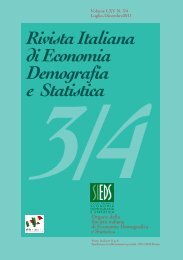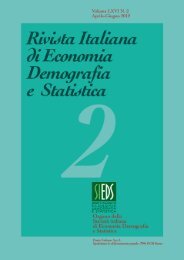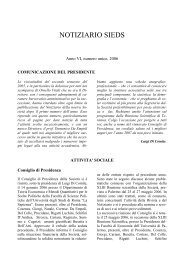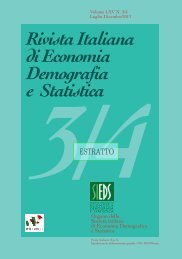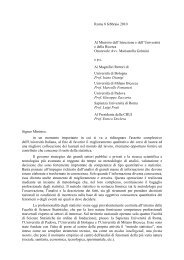rivista italiana di economia demografia e statistica - Sieds
rivista italiana di economia demografia e statistica - Sieds
rivista italiana di economia demografia e statistica - Sieds
Create successful ePaper yourself
Turn your PDF publications into a flip-book with our unique Google optimized e-Paper software.
34<br />
Volume LXIII nn. 3-4 – Luglio-Dicembre 2009<br />
In a similar way we eliminate education and demographic characteristics from<br />
the income generating model, obtaining the pre<strong>di</strong>cted values netted out,<br />
respectively, of the two groups effects. We compute the Gini indexes, ˆ and<br />
G<br />
Occ , Dem<br />
G ˆ<br />
Occ , Edu<br />
, to obtain education and demographic characteristics contributions as<br />
follows<br />
1 ˆ ˆ<br />
1<br />
C G − G , C Gˆ<br />
− Gˆ<br />
. (5)<br />
Edu<br />
=<br />
TOT Occ,<br />
Dem<br />
Dem<br />
=<br />
TOT Occ,<br />
Edu<br />
The second round estimates the contribution of factors dropped two groups at a<br />
time from equation (2). The idea is to isolate the effect of one group starting with<br />
the Gini indexes where only two grops are considered. From the first round we<br />
have G ˆ Edu , Dem<br />
, G ˆ Occ , Dem and G ˆ<br />
Occ , Edu , the total inequality given by the groups<br />
couples. If the aim is to obtain the occupation contribution, we can start with<br />
G ˆ but also Occ , Dem<br />
G ˆ<br />
Occ ,<br />
, so eliminating, respectively, the effect of demographic<br />
Edu<br />
characteristics or education. The contribution of occupation in the second round<br />
will be the average between<br />
C and<br />
21<br />
Occ<br />
C<br />
22<br />
Occ<br />
. We can estimate the contribution of<br />
the other two groups using the same procedure.<br />
If we continue with the logic of group elimination, the groups contribution at<br />
the final round will be derived by the <strong>di</strong>fference between, respectively, Ĝ ,<br />
Ĝ<br />
Edu<br />
, Ĝ<br />
Dem<br />
and the Gini index computed using the equation<br />
Yˆ<br />
= βˆ<br />
+ βˆ<br />
0 4Z.<br />
(6)<br />
Finally the contributions at each round are averaged across all rounds to obtain<br />
the total marginal effect of each group on total inequality.<br />
4. Variables<br />
The dependent variable used in the analysis is the logarithm of the households<br />
expen<strong>di</strong>ture as proxy for the income. We considered, as determinants for the<br />
households expen<strong>di</strong>ture, groups of variables related to occupation, education and<br />
demographic characteristics. Although we include in the income generating<br />
equation several explanatory variables, we will decompose inequality only into<br />
Occ



